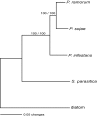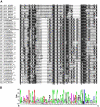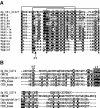Expressed sequence tags from the oomycete fish pathogen Saprolegnia parasitica reveal putative virulence factors
- PMID: 16076392
- PMCID: PMC1192801
- DOI: 10.1186/1471-2180-5-46
Expressed sequence tags from the oomycete fish pathogen Saprolegnia parasitica reveal putative virulence factors
Abstract
Background: The oomycete Saprolegnia parasitica is one of the most economically important fish pathogens. There is a dramatic recrudescence of Saprolegnia infections in aquaculture since the use of the toxic organic dye malachite green was banned in 2002. Little is known about the molecular mechanisms underlying pathogenicity in S. parasitica and other animal pathogenic oomycetes. In this study we used a genomics approach to gain a first insight into the transcriptome of S. parasitica.
Results: We generated 1510 expressed sequence tags (ESTs) from a mycelial cDNA library of S. parasitica. A total of 1279 consensus sequences corresponding to 525944 base pairs were assembled. About half of the unigenes showed similarities to known protein sequences or motifs. The S. parasitica sequences tended to be relatively divergent from Phytophthora sequences. Based on the sequence alignments of 18 conserved proteins, the average amino acid identity between S. parasitica and three Phytophthora species was 77% compared to 93% within Phytophthora. Several S. parasitica cDNAs, such as those with similarity to fungal type I cellulose binding domain proteins, PAN/Apple module proteins, glycosyl hydrolases, proteases, as well as serine and cysteine protease inhibitors, were predicted to encode secreted proteins that could function in virulence. Some of these cDNAs were more similar to fungal proteins than to other eukaryotic proteins confirming that oomycetes and fungi share some virulence components despite their evolutionary distance
Conclusion: We provide a first glimpse into the gene content of S. parasitica, a reemerging oomycete fish pathogen. These resources will greatly accelerate research on this important pathogen. The data is available online through the Oomycete Genomics Database.
Figures




Similar articles
-
Distinctive expansion of potential virulence genes in the genome of the oomycete fish pathogen Saprolegnia parasitica.PLoS Genet. 2013 Jun;9(6):e1003272. doi: 10.1371/journal.pgen.1003272. Epub 2013 Jun 13. PLoS Genet. 2013. PMID: 23785293 Free PMC article.
-
Galleria melonella as an experimental in vivo host model for the fish-pathogenic oomycete Saprolegnia parasitica.Fungal Biol. 2018 Feb-Mar;122(2-3):182-189. doi: 10.1016/j.funbio.2017.12.011. Fungal Biol. 2018. PMID: 29458721 Free PMC article.
-
Correlation Between Effector Gene Expression Targeted by lncRNAs in the Oomycete Fish Pathogen, Saprolegnia parasitica.Mar Biotechnol (NY). 2024 Nov 22;27(1):3. doi: 10.1007/s10126-024-10385-x. Mar Biotechnol (NY). 2024. PMID: 39576381
-
Entry of oomycete and fungal effectors into plant and animal host cells.Cell Microbiol. 2011 Dec;13(12):1839-48. doi: 10.1111/j.1462-5822.2011.01659.x. Epub 2011 Aug 25. Cell Microbiol. 2011. PMID: 21819515 Review.
-
Phytophthora parasitica: a model oomycete plant pathogen.Mycology. 2014 Jun;5(2):43-51. doi: 10.1080/21501203.2014.917734. Epub 2014 May 19. Mycology. 2014. PMID: 24999436 Free PMC article. Review.
Cited by
-
Survey and analysis of microsatellites from transcript sequences in Phytophthora species: frequency, distribution, and potential as markers for the genus.BMC Genomics. 2006 Sep 28;7:245. doi: 10.1186/1471-2164-7-245. BMC Genomics. 2006. PMID: 17007642 Free PMC article.
-
Identification of two GH18 chitinase family genes and their use as targets for detection of the crayfish-plague oomycete Aphanomyces astaci.BMC Microbiol. 2009 Aug 31;9:184. doi: 10.1186/1471-2180-9-184. BMC Microbiol. 2009. PMID: 19719847 Free PMC article.
-
Development and comparison of loop-mediated isothermal amplification with quantitative PCR for the specific detection of Saprolegnia spp.PLoS One. 2021 Dec 13;16(12):e0250808. doi: 10.1371/journal.pone.0250808. eCollection 2021. PLoS One. 2021. PMID: 34898622 Free PMC article.
-
Transcriptome of Aphanomyces euteiches: new oomycete putative pathogenicity factors and metabolic pathways.PLoS One. 2008 Mar 5;3(3):e1723. doi: 10.1371/journal.pone.0001723. PLoS One. 2008. PMID: 18320043 Free PMC article.
-
Genetic Analyses of Saprolegnia Strains Isolated from Salmonid Fish of Different Geographic Origin Document the Connection between Pathogenicity and Molecular Diversity.J Fungi (Basel). 2021 Aug 30;7(9):713. doi: 10.3390/jof7090713. J Fungi (Basel). 2021. PMID: 34575751 Free PMC article.
References
-
- Oomycete Genomics Database (OGD) http://www.oomycete.org
-
- Neish GA, Hughes GC. Fungal diseases of fishes, Book 6. Neptune, New Jersey, USA, T.W.F. Publications; 1980.
-
- Willoughby LG, Pickering AD. Viable Saprolegniaceae spores on the epidermis of the salmonid fish Salmo trutta and Salmo alpinus. Trans Br Mycol Soc. 1977;68:91–95.
-
- Bly JE, Lawson LA, Abdel-Aziz ES, Clem LW. Channel catfish, Ictalurus punctatus, immunity to Saprolegnia sp. J Appl Aquacult. 1994;3:35–50.
-
- Hatai K, Hoshiai GI. Pathogenicity of Saprolegnia parasitica Coker. In: Mueller GJ, editor. Salmon Saprolegniasis. Portland, Oregon, U.S. Department of Energy, Bonneville Power Administration; 1994. pp. 87–98.
Publication types
MeSH terms
Substances
LinkOut - more resources
Full Text Sources
Other Literature Sources

